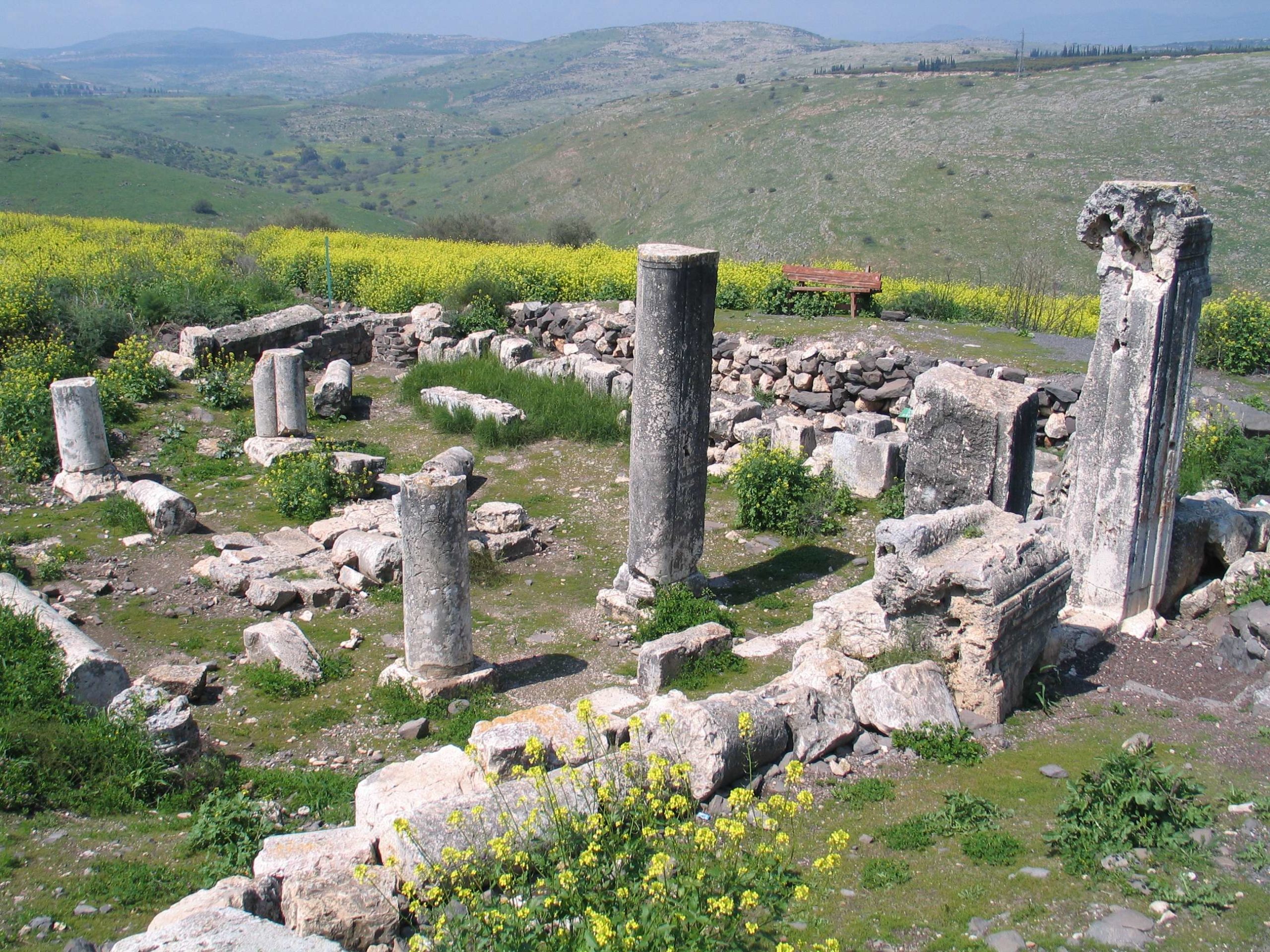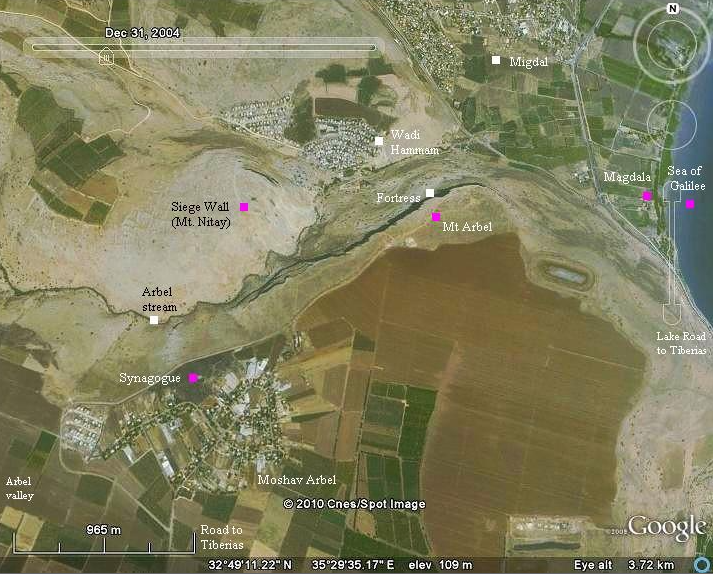Arbel
 Remains of the Ancient Synagogue at Arbel
Remains of the Ancient Synagogue at ArbelSource: Burkvoed - Wikipedia
| Transliterated Name | Language | Name |
|---|---|---|
| Arbel | Hebrew | אַרְבֵּל |
| Hittin | Arabic | حطّين |
| Hattin | Arabic | حَـطِّـيْـن |
Arbel is located in the Galilee ~8 km. from Tiberias. The site has a long history of habitation and is mentioned in the Hebrew Bible as Beth-Arbel in Hosea 10:14. After the crusader period, settlement appears to have declined (Ilan and Izdarechet in Stern et al, 1993). Arbel contains the remains of an ancient synagogue that may have been damaged or destroyed in the 6th century CE and again in the 8th century CE by one of the Sabbatical Year Quakes.
The ancient settlement of Arbel is located in the eastern Lower Galilee, on the summit of Mount Nittai, to the north of Nahal Arbel (map reference 1955.2467). The site is mentioned in the Bible only once, in the prophecy of Hosea (10: 14), as Beth-Arbel. Arbel was the residence of Nittai of Arbela, the colleague of Joshua ben Perahiah-the second "pair" of early Torah scholars mentioned in the Mishnah(Avot 1, 6-7; Hag. 2, 2)during the Second Temple period. During Bacchides' campaign against Judea, fortified caves called "Mesaloth in Arbela" were captured (1 Mace. 9:2), and when Herod fought the Galilean Zealots, the Hasmonean loyalists fortified themselves in Arbela (Josephus, Antiq. XIV, 415-430; War I, 305-313). References to rabbis who visited Arbel or studied here attest to there being a beth midrash (a place of study). The ninth of the priestly watches, Jeshua-Nisraf, resided in the city. Arbel was noted for its grain and its flax, from which the local inhabitants wove linen. In the Talmud and piyyutim and in the Salvation literature of the sixth and seventh centuries CE, the valley of Arbel is mentioned as the place in which the redemption would begin, after a decisive battle there. Travelers' accounts and descriptions of the tombs of the righteous record the traditions that this was the burial site of Nittai of Arbela; Dinah, the daughter of Jacob, and several of her brothers; Seth the son of Adam; Rabbi Zeira; and the exilarch Hezekiah. A few travelers mention the remains of a magnificent synagogue here, ascribed to Nittai of Arbela or to Rabbi Simeon bar Yohai.
After the Crusader period, settlement at Arbel seems to have declined. The Ottoman tax lists indicate that at the end of the sixteenth century it was displaced by the nearby settlement of Hittin and its name distorted to Irbid.
The synagogue at Arbel was described by E. Robinson in 1852. Fourteen years later, the Palestine Exploration Fund expedition conducted one of its early surveys at Arbel and published a site plan. About forty years after that, H. Kohl and C. Watzinger excavated here. Their excavations were conducted in the northern and northeastern parts of the synagogue's prayer hall and possibly in the southwestern part of the building.
At the end of the 1960s, the building was reexamined by N. Avigad, on behalf of the Hebrew University. He proposed that the niche in the southern wall is an organic part of the building and not the mihrab (prayer niche) of a mosque, as the earlier excavators thought. In 1971, Z. Yeivin drew a plan of the building that differed from previous versions: in place of a longhouse with a north-south orientation, he proposed a transverse building, comprising only part of the visible ruins, with an east-west orientation.
In 1987-1988, restoration and preservation of the building and its environs, courtyard, and ancillary rooms were begun, under the direction of Z. Ilan and A. Izdarechet.
- Biblical Map of Arbel
from BibleWalks.com
- Annotated Satellite view of
Arbel and environs from BibleWalks.com
- Aerial view of synagogue
from BibleWalks.com
- Arbel in Google Earth
- Arbel on govmap.gov.il
- Plan of the synagogue in its
earlier and later phases from Stern et al. (1993 v. 1)

 Arbel: plan of the synagogue in its earlier (left) and later (right) phases
Arbel: plan of the synagogue in its earlier (left) and later (right) phases
Stern et al. (1993 v. 1) - Reconstruction of the early phase
of the synagogue from Stern et al. (1993 v. 1)

 Arbel: reconstruction of the early phase of the synagogue.
Arbel: reconstruction of the early phase of the synagogue.
Stern et al. (1993 v. 1)
| Effect | Location | Image (s) | Comments |
|---|---|---|---|
| Presumed collapsed wall, roof, and column collapse | Synagogue
 Arbel: plan of the synagogue in its earlier (left) and later (right) phases
Arbel: plan of the synagogue in its earlier (left) and later (right) phasesStern et al. (1993 v. 1) |
|
-
Earthquake Archeological Effects chart
of Rodríguez-Pascua et al (2013: 221-224)

 Earthquake Archeological Effects (EAE)
Earthquake Archeological Effects (EAE)
Rodríguez-Pascua et al (2013: 221-224)
| Effect | Location | Image (s) | Comments | Intensity |
|---|---|---|---|---|
| Presumed collapsed wall, roof, and column collapse | Synagogue
 Arbel: plan of the synagogue in its earlier (left) and later (right) phases
Arbel: plan of the synagogue in its earlier (left) and later (right) phasesStern et al. (1993 v. 1) |
|
VIII+ |
Abel, in: RB, 33 (1924), 380ff.; idem
Avigad, N. and H.Z. Hirschberg, H.Z. (eds.), Kol Ereẓ Naftali (1967), 98–100
Avi-Yonah, Geog, 140; EM, 2 (1954), 68; Press, Ereẓ, 1 (1951), 34–36
Kohl, H. and Watzinger, C., Antike Synagogen in Galilaea (1916), 59
Ilan, Z. Ancient Synagogues in Israel (1991), 116–18.
Klein, S. (ed.), Sefer ha-Yishuv, 1 (1939), 163
Les Livres des Maccabées (1949), 159
Sukenik, in: JPOS, 15 (1935), 143
Tsafrir, Y., Di Segni, L., and Green, J., Tabula Imperii Romani. Iudaea – Palaestina. Maps and Gazetteer. (1994), 168–68
Urman, D. and Flesher, P.V.M. (eds.), Ancient Synagogues, vol. I (1995)
Vitto, F. "Synagogues in Cupboards," in: Eretz Magazine, 52 (1997), 36–42
Entry for Arbel in the Jewish Virtual Library
Brochure for Arbel National Park and Nature Reserve (in English) -
the brochure suggests that the synagogue rebuild took place in the 6th century CE and final destruction took place in 749 CE.
Arbel at BibleWalks.com
S. Klein, Beiträge zur Geographie und Geschichte Galilaeas (Ph.D. diss., Heidelberg), Leipzig 1909
G. H.
Dalman, ZDPV 29 (1906), 199–200
G. Foerster, The Galilean Synagogues and Their Relation to Hellenistic
and Roman Art and Architecture, 1–2 (Ph.D. diss.), Jerusalem 1972
D. Chen, LA 36 (1986), 235–240
39
(1989), 199–206
Z. Ilan, ESI 6 (1987–1988), 110
7–8 (1988–1989), 8–9
9 (1989–1990), 17–18
id., Eretz
Magazine 4/1 (1988–1989), 60–69
id., IEJ 39 (1989), 100–102
id. (& A. Izdarechet), MdB 57 (1989),
54–57
A. Van der Heyden, Ariel, Eng. ed. 82 (1990), 74–86
Y. Shahar & Y. Tepper, Cathedra 61 (1991),
191
M. Gichon, Historische Interpretationen (G. Walser Fest.
ed. M. Weinmann-Walser), Stuttgart 1995,
61–79
Z. Safrai, Studies in Historical Geography, Leiden 2000, 82–83.




